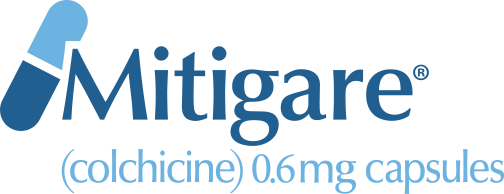
Gout is a painful type of inflammatory arthritis that affects more than 8 million people in the US.1 Nearly three times as many men as women have gout.1 However, the risk of gout can increase as a woman gets older.2 Read on to find out more about gout in women.
Understanding gout
Gout is caused by a build-up of uric acid crystals in the joints.1 These needle-shaped crystals can form when there is too much uric acid in the bloodstream.3
Uric acid is produced when the body breaks down chemicals called purines.3 Purines occur naturally in your body.3 They are also found in certain foods and drinks including organ meats, some seafood and beer.3
In most people, purines are converted to uric acid by the body and eliminated in the urine.3 In adults with gout, however, uric acid can build up in the bloodstream.3 When uric acid builds up, urate crystals can form in the joints and trigger a gout flare.3
Recognizing a gout flare
A gout flare is an episode in which a joint becomes extremely painful, red, swollen and/or tender.3 Discomfort may linger for a while after the most intense pain subsides—anywhere from a few days to a few weeks.3 Gout flares typically happen in the middle of the night.3 Many adults who have experienced them say that it feels like the affected joint is on fire.3 Others describe it as throbbing, crushing pain.4
Who is affected by gout
Gout is much more common in men.1 About 6 million men have gout in the US, compared to about 2 million women.1 The risk of the disease tends to increase with age.3 The average age of onset for gout in women is 66 years old.2
How gout in women is different than in men
Unlike men, who typically experience their first gout flare in the big toe, women tend to first develop gout in their hands, wrists, elbows and ankles.2 The average age of onset for men is around 54 years old; women tend to develop gout several years later.2 Regarding risk factors, men with gout are more likely to drink alcohol.2 Women with gout are more likely to use diuretics.2
The connection between gout and menopause
Gout in women is unusual prior to menopause.2 Researchers believe that estrogen may have a protective effect because it helps the body eliminate uric acid.2 Once the estrogen level in a woman’s body drops during menopause, however, she is more likely to develop gout.2
What to do if you think you have gout
If you think you could have gout, contact your doctor as soon as possible. Your doctor can examine you and perform tests to determine if your symptoms are caused by gout or another medical condition. The sooner you determine what is causing your symptoms, the sooner you can try to find relief.
How gout is treated
Whether you’re male or female, you don’t have to suffer with gout. Treatments for gout and medications to help adults prevent gout flares are available.4 Talk with your doctor about these medications and whether one of them might be right for you.
There are other ways to reduce your risk of flares as well. These include lifestyle changes like altering your diet, drinking more water and losing weight if needed.5
Don’t wait
Without treatment, gout flares can become more frequent, last longer, and may spread to other joints.6 In addition, a person with gout can develop tophi, which are visible, chalky white uric acid deposits that build up under the skin.4 Eventually, gout can limit movement and cause chronic pain.6
If you think you might have gout, be sure to talk to your doctor about it as soon as possible. You may even want to download the Gout Flare Questionnaire from our resources for patients and take it to your appointment. Your doctor can give you advice and even prescription medication that can help you prevent painful flares.
NOTE: This article was not written by a medical professional and is not intended to substitute for the guidance of a physician. These are not West-Ward’s recommendations for gout flare prevention, but rather facts and data collected from various reliable medical sources. For a full list of resources and their attributing links, see below.
